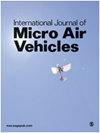A simulation-based approach to modeling component interactions during design of flapping wing aerial vehicles
IF 1.5
4区 工程技术
Q2 ENGINEERING, AEROSPACE
引用次数: 4
Abstract
A new flapping wing aerial vehicle (FWAV) simulation methodology is presented that combines models of the key subsystems: (1) the actuator, (2) the battery, and (3) the wings. This approach captures component interactions that are inherently coupled in order to realize system-level designs for optimal system performance. The approach demonstrates that coupling between wing sizing, flapping motions, and loading conditions propagate into the motor–battery model to alter system-level performance properties. For the actuator subsystem model, a generalized servo motor using empirically derived coefficients to describe torque and angular velocity bandwidth in terms of voltage and current. This model is coupled with a lithium polymer battery model accounting for the nonlinear voltage drop and capacity derating effects associated with loading conditions. For aerodynamic predictions of the wing subsystem, a blade element model for predicting aerodynamic forces is coupled with an elastic wing deformation model that accounts for bending and twisting of the blade elements. System-level performance is then modeled in a design case study by coupling all of the subsystem models to account for relevant interactions, which generates a design trade space spanning a range of wing sizes, airspeeds, and flapping condition. The results from the simulation offer insight into vehicle configuration settings that provide maximum performance in terms of lift and endurance for the Robo Raven II flapping wing aerial vehicle. Experimental validation of the modeling approach shows good predictive accuracy. In addition, the presented framework offers a generalized approach for coupling interacting subsystems to improve overall predictive accuracy and identify areas where component-level improvements may offer system-level performance gains.一种基于仿真的扑翼飞行器设计过程中部件相互作用建模方法
提出了一种新的扑翼飞行器(FWAV)仿真方法,该方法结合了关键子系统的模型:(1)致动器、(2)电池和(3)机翼。这种方法捕获固有耦合的组件交互,以便实现系统级设计以获得最佳系统性能。该方法表明,机翼尺寸、扑动和载荷条件之间的耦合传播到电机-电池模型中,以改变系统级的性能特性。对于致动器子系统模型,广义伺服电机使用经验导出的系数来描述电压和电流方面的转矩和角速度带宽。该模型与锂聚合物电池模型相结合,考虑了与负载条件相关的非线性电压降和容量降额效应。对于机翼子系统的空气动力学预测,用于预测空气动力的叶片元件模型与考虑叶片元件的弯曲和扭曲的弹性机翼变形模型相耦合。然后,在设计案例研究中,通过耦合所有子系统模型来对系统级性能进行建模,以考虑相关的相互作用,从而产生一个跨越一系列机翼尺寸、空速和扑动条件的设计交易空间。模拟结果提供了对飞行器配置设置的深入了解,这些设置为Robo Raven II扑翼飞行器在升力和耐力方面提供了最大性能。实验验证了该建模方法具有良好的预测精度。此外,所提出的框架提供了一种耦合交互子系统的通用方法,以提高整体预测精度,并确定组件级改进可以提供系统级性能增益的领域。
本文章由计算机程序翻译,如有差异,请以英文原文为准。
求助全文
约1分钟内获得全文
求助全文
来源期刊

International Journal of Micro Air Vehicles
ENGINEERING, AEROSPACE-
CiteScore
3.00
自引率
7.10%
发文量
13
审稿时长
>12 weeks
期刊介绍:
The role of the International Journal of Micro Air Vehicles is to provide the scientific and engineering community with a peer-reviewed open access journal dedicated to publishing high-quality technical articles summarizing both fundamental and applied research in the area of micro air vehicles.
 求助内容:
求助内容: 应助结果提醒方式:
应助结果提醒方式:


